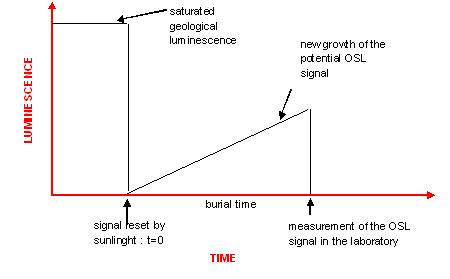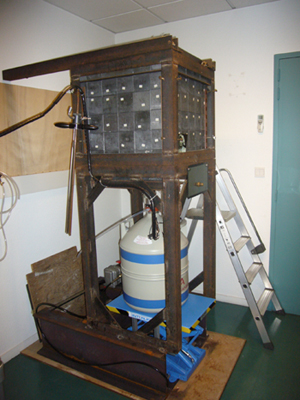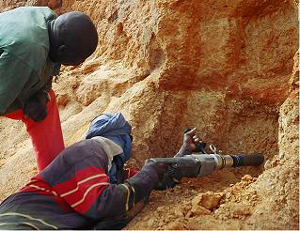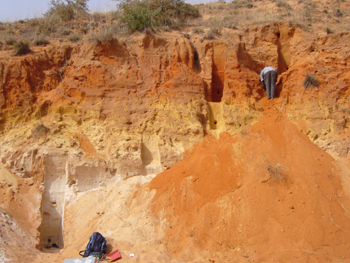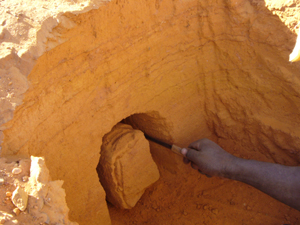Introduction
In West Africa, preservation conditions of the sediments have only rarely been favorable to the recording of long sedimentary and archaeological sequences. Most of the artifacts are surface finds, making it difficult, if not impossible, to place them in chronological context, whether it be relative or absolute. However, in the Dogon Country, deep sedimentary deposits have been preserved in several sectors, trapping abundant evidence of human occupations during the Paleolithic and making it possible to study their chronology.
While the range of applicable dating methods is limited, given the exclusive preservation of mineral materials, with the exception of Holocene charcoals, conditions are favorable for dating by optically stimulated luminescence (OSL): the sediments are mainly formed of quartz, which, moreover, has a particularly strong luminescence signal in this region.
The radioactive elements of the uranium, thorium and potassium families are naturally present in very low amounts in all sediments. Radioactive decay is accompanied by energy release, some of which is absorbed by nearby minerals. When these are subjected to light stimulus, the accumulated energy in the crystalline networks is released, causing a light emission: this is optically stimulated luminescence or OSL. When sediment is exposed to natural light prior to deposition, the OSL acquired over geological time is removed. The “luminescent” chronometry is thus reset to zero. The OSL then accumulates in response to the ionizing radiation received during the burial period. The OSL level observed in ancient samples is thus dependent on the absorbed radiation dose, and hence can be related to the time elapsed since last heating/illumination once the dose received per year (during burial) has been calculated.
Age (ka) = Dose équivalente (Gy) / débit de dose (Gy/ka)
Some elements of methodology
Several techniques are possible for OSL sampling, the principle being to always avoid accidental exposure to light. At Ounjougou, nocturnal samples were forbidden. In fact, there is a local belief that water genies which live at the confluence of the four rivers, prevent humans (women in particular) from being in their domain at night. Unless goats were sacrificed, which we preferred to avoid, disasters could occur if this rule was not respected. More simply, given the compactness of the sediments, the technique most often used was the preparation of small blocks 1 dm3, which were cut again in the laboratory under red or orange light that does not affect the OSL signal.
The dose rate was determined by combining several analytical techniques: gamma spectrometry in the field, high resolution gamma spectrometry in the laboratory or
ICP-MS (Inductively Coupled Plasma Mass Spectrometry). To calculate the equivalent dose, the single grain technique was preferentially used because it better permits analysis of the uniformity of the sediment: the grains do not all have the same history. If the origin of the sediments is eolian, a large part would have undergone reworking by water, which could have caused variability in the degree of bleaching. Also, termites (and other insects), very active, may have occasionally caused contamination by much younger material in the Pleistocene levels or a mixture of ancient layers. It is important to identify the poorly bleached and intrusive grains and remove them from the calculation of the mean equivalent dose for the age to have any meaning.
Work carried out 2000-2008
Chronological studies by OSL began in 2000 under the responsibility of S. Stokes in the Department of Geography at the University of Oxford. They are currently under the responsibility of C. Tribolo by the geochronology teams at the Centre de Recherche en Physique Appliquée à L’Archéologie (IRAMAT-UMR 5060, CNRS, University of Bordeaux).
Analyses carried out first focused on the Pleistocene of the complex of Paleolithic sites at Ounjougou. They show that in the Yamé Valley, the sedimentary deposits preserved and many traces of human occupations were primarily concentrated in OIS 4 and 3 (74-24 ka). Older than this, sediments are often partially eroded or considerably altered, but still contain evidence of human occupation. OIS 2 (24-12 ka) is still poorly defined and it is only at the beginning of the Holocene that we find significant sedimentary deposits and definite human occupations.
Similar work is being done in the piedmont valley, below the cliff villages of Yawa and Songona. Hills some 30 m high evidence significant sedimentary deposition during OIS 4 and 3, in which are found several Paleolithic sites. These remains and the sedimentary dynamic will be compared with the Ounjougou discoveries once the ages are precisely determined.
Finally, other sites in the region (Kobo 1 rock shelters and Abri des Vaches) have been studied to better define the Pleistocene-Holocene transition and/or the appearance of microlithic industries.

